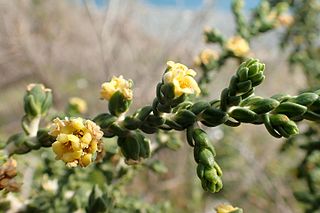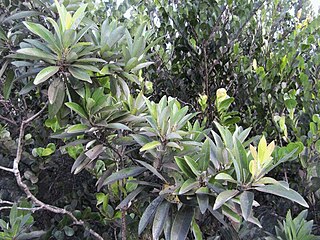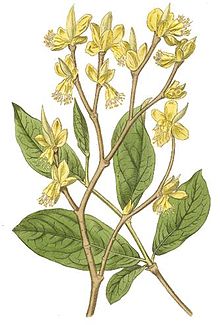
Quercus palustris, also called pin oak, swamp oak, or Spanish oak, is a tree in the red oak section of the genus Quercus. Pin oak is one of the most commonly used landscaping oaks in its native range due to its ease of transplant, relatively fast growth, and pollution tolerance.

The marsh tit is a passerine bird in the tit family Paridae and genus Poecile, closely related to the willow tit, Père David's and Songar tits. It is a small bird, around 12 cm (4.7 in) long and weighing 12 g (0.42 oz), with a black crown and nape, pale cheeks, brown back and greyish-brown wings and tail. Between 8 and 11 subspecies are recognised. Its close resemblance to the willow tit can cause identification problems, especially in the United Kingdom where the local subspecies of the two are very similar: they were not recognised as separate species until 1897.

The marsh warbler is an Old World warbler currently classified in the family Acrocephalidae. It breeds in temperate Europe and the western Palearctic and winters mainly in southeast Africa. It is notable for incorporating striking imitations of a wide variety of other birds into its song.

The longleaf pine is a pine species native to the Southeastern United States, found along the coastal plain from East Texas to southern Virginia, extending into northern and central Florida. In this area it is also known as "yellow pine" or "long leaf yellow pine", although it is properly just one out of a number of species termed yellow pine. It reaches a height of 30–35 m (98–115 ft) and a diameter of 0.7 m (28 in). In the past, before extensive logging, they reportedly grew to 47 m (154 ft) with a diameter of 1.2 m (47 in). The tree is a cultural symbol of the Southern United States, being the official state tree of Alabama. This particular species is one of the eight pine tree species that falls under the "Pine" designation as the state tree of North Carolina.

Caltha palustris, known as marsh-marigold and kingcup, is a small to medium size perennial herbaceous plant of the buttercup family, native to marshes, fens, ditches and wet woodland in temperate regions of the Northern Hemisphere. It flowers between April and August, dependent on altitude and latitude, but occasional flowers may occur at other times.

Eucryphia is a small genus of trees and large shrubs native to the south temperate regions of South America and coastal eastern Australia, mainly Tasmania. Sometimes placed in a family of their own, the Eucryphiaceae, more recent classifications place them in the Cunoniaceae. There are seven species, two in South America and five in Australia, and several named hybrids.

The Thymelaeaceae are a cosmopolitan family of flowering plants composed of 50 genera and 898 species. It was established in 1789 by Antoine Laurent de Jussieu. The Thymelaeaceae are mostly trees and shrubs, with a few vines and herbaceous plants.

Dirca is a genus of three or four species of flowering plants in the family Thymelaeaceae, native to North America. The genus is named after Dirce in Greek mythology. The general common name for this deciduous shrub is leatherwood; other names include moosewood, ropebark and the Powhatan-derived name wicopy. The stems of Dirca are exceptionally pliable and the bark is difficult to tear by hand; for this reason, its stems were used by Native Americans in eastern North America as thongs or ropes. Members of the genus can grow to a maximum height of about three meters, and are often associated with rich, moist woods or slopes above creeks or streams.

Eucryphia lucida, the leatherwood, is a species of tree or large shrub endemic to forests of western Tasmania, Australia. An attractive plant used in both horticulture and apiculture, it was promoted by the Tasmanian Branch of the then SGAP as an alternative to the Tasmanian blue gum for Tasmania's floral emblem. It was described as E. billiarderi at one stage, this now being a synonym.

Comarum palustre, known by the common names purple marshlocks, swamp cinquefoil and marsh cinquefoil, is a common waterside shrub. It has a circumboreal distribution, occurring throughout North America, Europe, and Asia, particularly the northern regions. It is most commonly found on lake shores, marshy riversides and stream margins, often partly submerged with foliage floating. It is a parent of some Fragaria–Comarum hybrids, ornamental plants produced by crossing with strawberries.

Rosa palustris, the swamp rose, is a shrub in the rose family native to much of eastern North America. It can be found from Nova Scotia and New Brunswick in the north, south to Florida and west to Arkansas and Ontario. It is a host of the blinded sphinx moth and Coptotriche admirabilis.

Persea palustris, also known as swamp bay or swampbay, is a small tree or shrub found throughout the Southeastern United States and the Bahamas, with much of its range overlapping with that of its relative Persea borbonia. It is generally not more than 40 feet tall, with bark separated into scales by fissures across its surface. Mature leaves are green, paler on their undersides, which have prominent brownish or reddish-brown hairs. The species prefers swamps and coastal areas, particularly locations with moist, peat-rich soil. It is sensitive to the fungal disease known as laurel wilt, even more so than related species.
Palustris is a Latin word meaning "swampy" or "marshy", and may refer to:

Dirca occidentalis, the western leatherwood, is a deciduous shrub with leaves three to seven centimeters in length. Yellow flowers emerge prior to leafing. It grows on moist and shaded slopes. It is rare and endemic to the San Francisco Bay area of California. Its closest relative, Dirca palustris, lives in the eastern half of North America.
Eastern leatherwood is a common name for several plants and may refer to:
The Leatherwood Wilderness, a 16,838 acres (68.14 km2) federally designated wilderness area, is located within the Ozark-St. Francis National Forest in Arkansas is the largest wilderness area in Arkansas. The US Congress designated the Leatherwood Wilderness in 1984 and the US Forest Service manages the land.

Delphinium exaltatum, known by the common name tall larkspur, is a species of flowering plant in the genus Delphinium, part of the buttercup family. Other Delphinium species are also commonly known as tall larkspur, such as Delphinium barbeyi. D. exaltatum is native to the central and eastern United States, where it can be found in Kentucky, Maine, Ohio, Pennsylvania, Maryland, West Virginia, Virginia, North Carolina, Alabama, Tennessee, and Missouri.

Mimetes palustris or cryptic pagoda is an evergreen shrub, assigned to the family Proteaceae. It has horizontal sprawling shoots as well as upright, unbranched shoots usually about ½ m (1½ in) high. The leaves are entire and stand out on the lower parts of the shoots, but are overlapping and pressed tightly against each other near the inflorescence, almost like a snakeskin. The inflorescence consists of several flowerheads, each containing three clear yellow flowers that are longer than the subtending leaves. It is the smallest species of Mimetes and is an endemic species that grows on well-drained, but permanently moist sandy and peaty slopes in the mountains near Hermanus, Western Cape province of South Africa. It is considered critically endangered. Flowering occurs all year round, but peaks in August and September.

Dirca decipiens, the Ozark leatherwood, is a deciduous shrub endemic to northwestern Arkansas, southeastern Kansas, and southwestern Missouri. It is distinguished from the more widespread eastern leatherwood by its sessile fruits and finely hairy leaves and stems.
Dirca mexicana, the Mexican leatherwood, is a low shrub with a very restricted population in Tamaulipas, Mexico. However, it does surprisingly well in the much colder environment of Ames, Iowa. Like most Dirca species, it blooms in early spring.



















